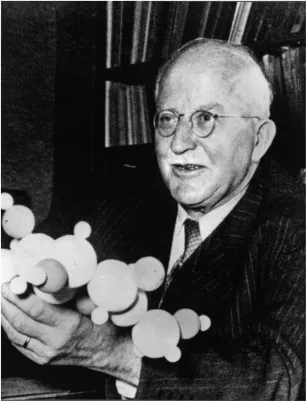
- English
- ePUB (mobile friendly)
- Available on iOS & Android
eBook - ePub
Fundamentals of Polymer Science for Engineers
About this book
Fundamentals of Polymer Science for Engineers
Filling a gap in the market, this textbook provides a concise, yet thorough introduction to polymer science for advanced engineering students and practitioners, focusing on the chemical, physical and materials science aspects that are most relevant for engineering applications.
After covering polymer synthesis and properties, the major section of the book is devoted to polymeric materials, such as thermoplastics and polymer composites, polymer processing such as injection molding and extrusion, and methods for large-scale polymer characterization. The text concludes with an overview of engineering plastics. The emphasis throughout is on application-relevant topics, and the author focuses on real-life, industry-relevant polymeric materials.
Frequently asked questions
Yes, you can cancel anytime from the Subscription tab in your account settings on the Perlego website. Your subscription will stay active until the end of your current billing period. Learn how to cancel your subscription.
At the moment all of our mobile-responsive ePub books are available to download via the app. Most of our PDFs are also available to download and we're working on making the final remaining ones downloadable now. Learn more here.
Perlego offers two plans: Essential and Complete
- Essential is ideal for learners and professionals who enjoy exploring a wide range of subjects. Access the Essential Library with 800,000+ trusted titles and best-sellers across business, personal growth, and the humanities. Includes unlimited reading time and Standard Read Aloud voice.
- Complete: Perfect for advanced learners and researchers needing full, unrestricted access. Unlock 1.4M+ books across hundreds of subjects, including academic and specialized titles. The Complete Plan also includes advanced features like Premium Read Aloud and Research Assistant.
We are an online textbook subscription service, where you can get access to an entire online library for less than the price of a single book per month. With over 1 million books across 1000+ topics, we’ve got you covered! Learn more here.
Look out for the read-aloud symbol on your next book to see if you can listen to it. The read-aloud tool reads text aloud for you, highlighting the text as it is being read. You can pause it, speed it up and slow it down. Learn more here.
Yes! You can use the Perlego app on both iOS or Android devices to read anytime, anywhere — even offline. Perfect for commutes or when you’re on the go.
Please note we cannot support devices running on iOS 13 and Android 7 or earlier. Learn more about using the app.
Please note we cannot support devices running on iOS 13 and Android 7 or earlier. Learn more about using the app.
Yes, you can access Fundamentals of Polymer Science for Engineers by Stoyko Fakirov in PDF and/or ePUB format, as well as other popular books in Technology & Engineering & Materials Science. We have over one million books available in our catalogue for you to explore.
Information
Part One
Introduction
If you once enter in the world of polymers, You will never leave it. T. Tsuruta
1
Introduction
1.1 Milestones in the Development of Polymer Science
Regarding its subject of study, polymer science belongs to the oldest fields of science (existing since the times when living cells appeared), while as a separate, well-defined science it was formulated less than 100 years ago – between 1920 and 1930 – thanks to the pioneering works of the German chemist Hermann Staudinger (Figure 1.1). Polymer materials have always been used by human beings without having any idea what differs these materials from the others. The situation did not change even when the first synthetic polymer material was prepared around 1910 by Leo Baekeland –Bakelite.1 First, Baekeland produced soluble phenol-formaldehyde shellac called “Novolak”, but later he succeeded in preparing a hard plastic material.

Figure 1.1 H. Staudinger (1881–1965), the “father of polymer science” who received the Nobel Prize in 1953 for his studies.
Bakelite continues to be used for wire insulation, brake pads and related automotive components, and industrial electric-related applications. Bakelite stock is still manufactured and produced in sheet, rod and tube form for industrial applications in the electronics, power generation, and aerospace industries, and under a variety of commercial brand names.
Baekeland was a very talented chemist with an extremely strong feeling for commercially important products. But as a matter of fact, he did not contribute to the creation of polymer science in any theoretical aspect such as, for example, trying to answer such questions as how does the molecular structure of polymeric substances differ from that of other substances.
It must be stressed that his target was completely different – to create a new material with a well-defined combination of properties needed for a particular application. And he completed his task in an excellent way! Today we know that even if he tried to perform theoretical research, he could hardly have the same success he achieved in material synthesis. This is because his polymer, Bakelite, belongs to a special group of polymers characterized by a rather dense molecular cross-linking, that is, the single molecular chains are connected via covalent bonds, forming in this way a giant three-dimensional (3-D) molecular network, where separate linear molecules with a strictly defined start and end no longer exist. What is more, the cross-linked polymers do not display the typical and unique properties of polymers as the non-cross-linked ones do. So, the answer to the question regarding why the molecular structure of polymeric substances differs from that of other substances was given by Hermann Staudinger, who was working around the same time.
Staudinger had been studying natural products as cellulosic derivatives, natural rubber, and others, and particularly their solutions. Thus he got the impression that in these solutions one deals with larger “particles” than in solutions of low molecular weight substances. By the way, the same observation had been made much earlier, around the mid-nineteenth century when the colloid chemistry was formulated and such solutions were called “lyophilic colloids.” Staudinger went further, suggesting that these “particles” are giant molecules comprised of a large number of atoms bonded via covalent bonds; and this met a negative reaction from the scientific world. The leading chemists and physicists of that time were against him, stating that it was not possible that such a large number of atoms could be bonded in one molecule.2
Staudinger did not abandon his idea, and step by step, he gathered arguments in favor of his hypothesis which, around 1930, was accepted world-wide. As a matter of fact, he formulated a new science, polymer science suggesting and proving that polymers are comprised of large molecules consisting of a huge number of atoms connected to each other by covalent bonds. In this way he demonstrated the basic difference in the molecular structure of polymers and low...
Table of contents
- Cover
- Title Page
- Copyright
- Dedication
- Preface
- Acknowledgments
- Part One: Introduction
- Part Two: Physical Properties of Polymers
- Part Three: Synthesis of Polymers
- Part Four: Polymer Materials and Their Processing
- Index
- End User License Agreement